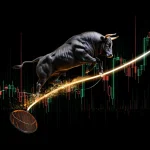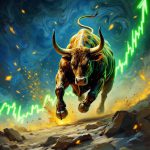
A Confession from the Peak of Euphoria
Jan 27, 2025
Have you ever wondered why the loudest celebrations occur right before markets stumble? Tales of instant wealth and unstoppable rallies often peak just before a downturn. In early 2008, proud property moguls toasted their good fortune while ignoring warning signs of creeping mortgage defaults. Similar exuberance preceded the dot-com collapse, when dot-com companies rode a wave of investor mania, only to see shares plunge soon after. These stories pose a stark question: could the crowd’s roar warn that a reversal is near?
For many, the notion that collective euphoria might signal imminent trouble goes against a common habit: painting soaring markets in flawless colours. Greed drives people to chase quick gains, seduced by headlines about record highs and mind-boggling profits. Friends boast of lucrative trades, adding to the pressure to join what appears to be a guaranteed ride to riches. But history teaches that markets are not always gentle with those who ignore basic caution. When the stampede turns, even experienced traders can sustain painful losses. The fear that once seemed irrational during the rally re-emerges with startling force.
Strangely, the same human impulses that spark a rush to buy can later create a race to sell at rock-bottom prices. Investment folklore is littered with examples of fortunes vanishing overnight, but it is also full of stories of individuals who treated market collapses as golden opportunities. Warren Buffett famously recommended being “fearful when others are greedy, and greedy when others are fearful,” capturing an idea at odds with the typical mania-panic cycle. Yet he was not simply referring to personal willpower. He hinted at a deeper truth: fear and greed shape collective decisions more strongly than countless spreadsheets or fancy business forecasts.
Groups shape thinking more than we might admit, often triggering market fear greed in ways that overshadow logical judgement. Psychologists point to herd behaviour as a key factor: individuals abandon their original opinions to conform with the crowd. A rally can speed up once each person sees others profiting and decides to join, amplifying the momentum. The same investors who once proclaimed shares overpriced suddenly feel compelled to buy, swayed by the idea that “everyone else is doing it.” Although small doses of conformity can pass unnoticed, extremes bring about reckless decisions.
A prime example appeared before the housing crisis of 2008. Many borrowed heavily, convinced that property prices were on a perpetual climb. Mortgage brokers encouraged that belief by offering generous loans on the premise that tomorrow’s house values would surpass today’s. Even banks, packaging these loans into seemingly foolproof financial products, felt untouchable. But after mortgage defaults mounted, investors abruptly offloaded the very assets they had treated as fail-safe. This spiral demonstrated how herd behaviour forms a massive bubble and then a sudden crash.
Fresh breakthroughs or upbeat earnings reports can stir similar reactions, ensuring that market fear greed remains a danger. When the crowd chases a dream of unlimited gains, a critical voice can be drowned out or ridiculed for doubting the excitement. Yet markets tend to move in cycles rather than a single upward line. By recognising the herd’s influence, a watchful investor notices when a cherished story grows too large. At that juncture, it may be prudent to rely on technical indicators that show the market tipping into a precarious zone. As soon as the signal hits, one might tighten stop losses or lock in profits, even if many remain entranced by the uptrend.
The Push and Pull of Fear and Greed
Few forces surpass the influence of market fear greed. The allure of substantial gains fuels ambition, while the dread of losses sparks hasty retreats. These impulses can drive investors into decisions that undercut their own interests. When share prices rise steadily, greed magnifies confidence, often tempting them to stake far more than is prudent. As markets crest, that same greed blinds them to any possibility of a downturn. If later the market wobbles, fear takes control, igniting frantic sell-offs that sometimes push valuations well below any sensible measure. Such actions run counter to the old advice of buying low and selling high, yet they persist because emotional reactions frequently overpower clear thinking.
Behavioural finance illustrates these patterns by showing how even experienced professionals can succumb to rash moves under stress. Fund managers may chase popular stocks out of fear of lagging behind peers, unsettled by the prospect of lower returns if they fail to join prevailing trends. Meanwhile, individual investors latch onto headlines promising meteoric profits, only to panic at the slightest hint of trouble and race to offload everything. Time and again, this wave-like sequence of market fear greed has fuelled booms and crashes, from the dot-com surge of the late 1990s to the 2008 fiasco.
Still, investors can find reason for optimism within this chaos. Historical records suggest that fear reaches its peak just as shares hover near attractive price levels, while greed exerts its greatest pull when valuations have soared to unsustainable highs. Recognising these rhythms helps some participants detach from the constant buzz. Instead of reacting with alarm to every snippet of financial news, they consult tools gauging whether the balance of buying and selling has become extreme. Such an approach can shield portfolios from the dramatic emotional swings that mark uncertain market phases, easing the turbulence caused by a volatile crowd.
Technical Tools for Taming Emotions
While acknowledging the profound effect of fear and greed is essential, practical tools are also necessary. Technical analysis offers numerical signals that can highlight when emotions have reached extremes. One such tool is the Relative Strength Index (RSI), which gauges whether a stock or index has climbed too far (overbought) or fallen too hard (oversold) in recent trading. Another popular metric is the Moving Average Convergence Divergence (MACD), tracking momentum shifts by comparing different moving averages. Though basic in design, these instruments can shine a light on moments when the crowd, in all its excitement or dread, has overreacted.
Various tech shares showed overstretched RSI levels in the months leading up to the dot-com collapse. These signals popped up like flashing lights on price charts. However, many traders ignored or dismissed them, too caught up in the frenzy to accept that a severe pullback was possible. The same phenomenon occurred just before the 2008 meltdown, with indicators hinting that certain financial assets were priced beyond reason. True, no one tool can predict the very top or bottom with pinpoint accuracy, and markets can remain at extreme levels for longer than many expect. But they do serve as a second opinion, a numerical prompt to question whether the latest mania or panic still has further to run.
Beyond these well-known techniques, some traders track volume spikes, candlestick patterns, or support and resistance lines. At times, a sudden burst of buying volume during a presumed panic can foreshadow a bottom as bargain hunters start snapping up undervalued shares. Equally, a sell-off at a major resistance line can halt a euphoric climb. Each indicator tells only part of the story, but combined, they can guide an investor who aims to act before the herd flips from greed to fear or vice versa. In short, technical tools foster discipline, helping to offset the psychological swings that so easily rattle the markets.
Strategic Buying in a Crisis
It might seem counterintuitive to buy while others are running for the exits, but history suggests this approach can pay off handsomely. When a crash occurs, everyone around you is usually convinced that economic doom is inevitable. Pessimistic headlines fill the news, and share prices tumble far below levels recorded just weeks or months earlier. In these bleak times, even well-run companies can be dragged down by a panicked stampede. Yet the investor who has set aside capital, studied fundamentals, and watched for technical signs of stabilisation can pick up bargains when no one else wants them.
The aftermath of the 2008 crisis stands as a prominent example. Though many banks and mortgage firms bore heavy losses, a range of healthy companies were also battered by the general mood of fear. Savvy participants who stepped in to buy blue-chip stocks at hugely discounted prices soon enjoyed a sharp rebound once the market realised these enterprises were still profitable. By late 2009 and into 2010, much of the panic subsided, and several neglected shares doubled or tripled in value from the lows. While timing the exact bottom is notoriously difficult, a willingness to buy when everyone else seems terrified has proved advantageous across decades of financial history.
A crucial aspect of strategic buying is recognising that patience and research are vital. Blindly scooping up any tumbling stock is dangerous, especially if its fundamentals are genuinely weak. Skilled bargain hunters look for oversold indicators, improving data, or at least signs that forced selling is nearing its end. They proceed with caution, gradually building positions rather than betting the farm all at once. This approach is guided by a belief that panic sells the good along with the bad, opening the door for those who maintain composure while the crowd succumbs to fear.
The Art of Selling Before the Bubble Bursts
While memorable bargains can appear during collapses, the other side of the coin involves knowing when to exit. Greed hides real risks by insisting that a rising market will keep climbing. Social media and financial magazines often enforce this view, spotlighting success stories and giant gains. Who wants to be the spoilsport who exits early and misses additional upside? Yet failing to sell near euphoric levels is how countless fortunes get wiped out in the subsequent crash.
Study the year 2000 for a lesson on how greed can blind even the best minds. During the late 1990s, internet stocks soared to extraordinary heights. Tech conferences buzzed with excitement, and day trading became a trendy pastime. Numerous amateurs quit full-time jobs to speculate in shares they barely understood. Yet as soon as the cracks started emerging—when earnings turned out to be flimsy, and easy capital began drying up—the bubble could not sustain its own mania. A swift sell-off crushed valuations, handing devastating losses to those unprepared to exit. On the other hand, those who had noticed warning signals, including steep RSI readings and repeated fails to break new highs, managed to take profits before the floor gave way.
Figuring out when to sell is not a matter of guessing the exact top. Savvy traders often unload positions bit by bit as stocks approach historically high price-to-earnings multiples or other danger zones. Certain technical benchmarks, such as a stock failing to reach a fresh high or an index dropping below a key moving average, can also serve as wake-up calls. The main point is to accept that no bull run endures forever. Even if a stock keeps climbing after one has exited, the stress saved by avoiding a nasty collapse is sometimes worth more than the potential extra gains.
Looking Beyond the Swings for Lasting Success
Emotion sometimes rules markets, yet those who study human tendencies and monitor price action can ride these shifts with greater confidence. Instead of viewing fear and greed as mere clichés, knowledgeable investors see them as forces that create waves in financial markets. When everyone roars about eternal prosperity, a reckoning may be close at hand. When the crowd views the outlook as hopeless, remarkable entries often emerge for those bold enough to act. By blending psychological lessons with fundamental checks and charts, one creates a style that stands apart from the extremes.
Seasoned professionals advise building a personal checklist. This might include scanning for overbought or oversold conditions, setting profit targets in advance, and watching for divergences between price and volume. It might also include self-reflection: “Am I feeling smug because my portfolio soared? Am I quaking at headlines that predict the end of civilisation?” If the answer to these questions indicates emotional extremes, that could be a clue to do the opposite of what the crowd is screaming. A technical confirmation, perhaps a sudden surge in selling volume or a failing rally, can reinforce the suspicion that a big shift is near.
In the final analysis, markets continue to oscillate between surges and slumps. The crowd’s mania and panic are not quirks to be neatly corrected by reason but persistent states that drive boom-bust cycles again and again. Fear and greed might never relax their hold on financial decisions. Yet an investor who accepts these forces and prepares accordingly can navigate turbulence far better than someone who places all faith in either raw emotion or pure logic. By uniting an awareness of mass behaviour, sound timing signals, and a willingness to act, one can stand aside from the crowd’s frenzy and make decisions that help secure both peace of mind and long-term rewards.
Above all, remember that success during frantic trading sessions often depends less on guessing tomorrow’s headlines and more on controlling one’s own impulses. An investor can transform fear and greed from foes into guides by leaning on data rather than hype, maintaining a watchful eye for overheated markets, and embracing moments of panic as potential bargains. Rather than falling victim to market storms, this approach allows each wave—be it a crash or a boom—to become an avenue for astute moves. It is an ongoing challenge that demands both emotional strength and technical discipline, but the results can be profoundly rewarding for those who choose to step away from the herd and heed history lessons.












